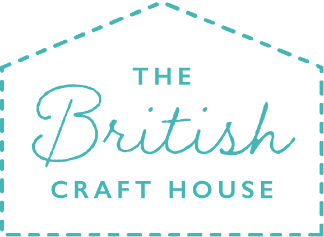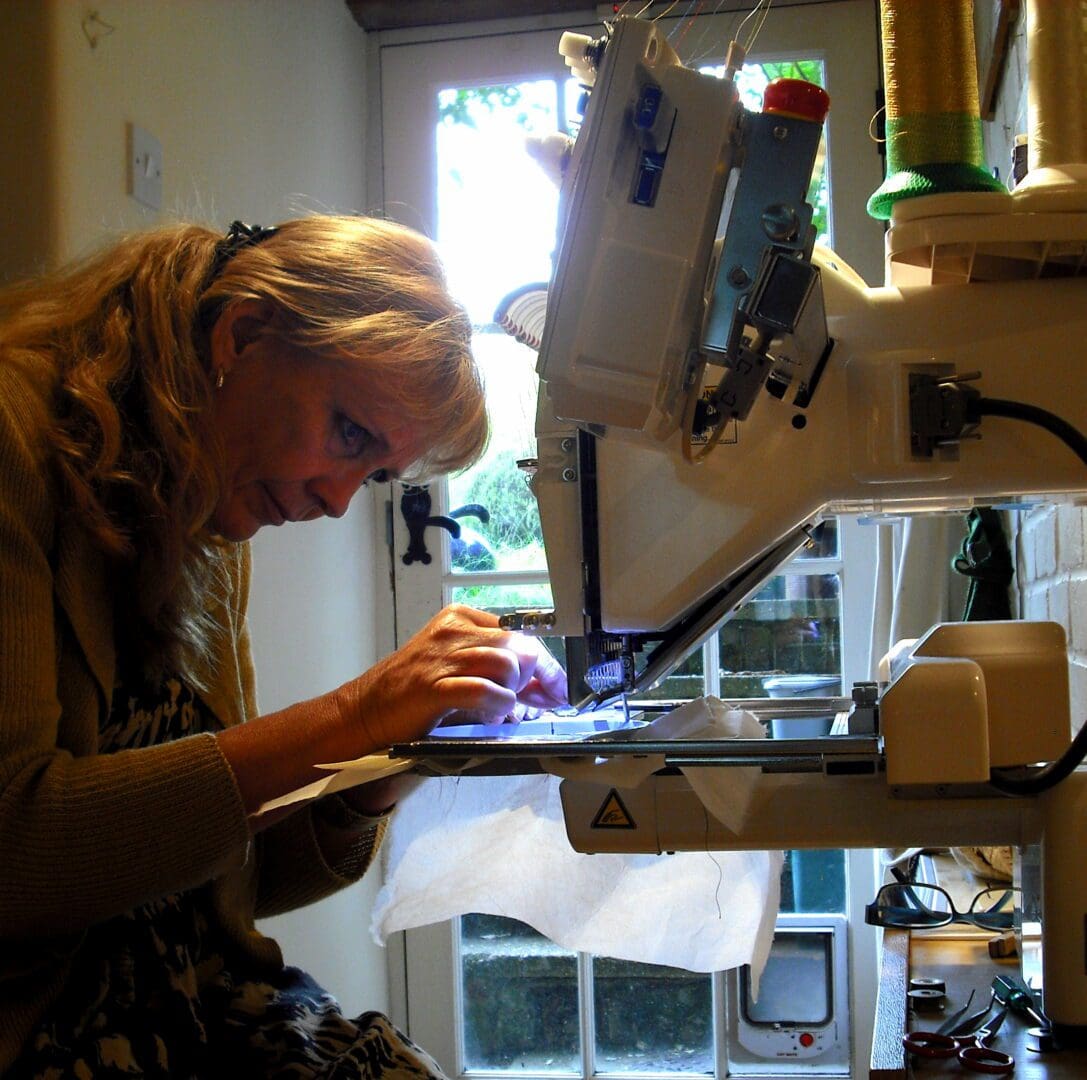
No machine however sophisticated can make anything beautiful unless it is skillfully instructed to do so and used as a tool, with understanding of the technology, materials and techniques and constantly pushing the creative boundaries.
There lies my skill, and my story.
I am never sure, looking back, if it was our rural location in Norfolk or a thrifty mother who went through the war, making the most of what one had, whose mantra was-
‘If you want something, you will have to make it’
that encouraged us, her three girls to be creative.
I was told I could use her electric Singer sewing machine as soon as I could work out how to sew a straight line……. which was simple really…. place the fabric carefully, lower the presser foot at the start and let the machine’s dog teeth feed, do the straight line.
My Dad was very creative, always planning projects with sketches on the back of old envelopes and as his youngest daughter, I loved to watch him work, whether it was outside laying bricks for a garden feature or standing ankle deep in heaps of fragrant coils of wood shavings that floated down around us as I stood next to him in his workshop, doing my best not to be in the way of his long arms and elbows as he was planing a piece of wood at the bench. It seems that I inherited Dad’s creativity and my Mum’s hoarding character for anything that might come in useful ……. and ……. both my Mum and Dad’s very long arms…
As a child, l was always happy to be making things and using my hands, I dabbled in most of the crafts, being taught to knit on four needles before I had even left primary school, was shown how to crochet by a kind farmers wife whilst my Dad was selling tractors and machinery to her husband and most of the farmers in Norfolk.
I rather scorned the paint by numbers gift set, using oil paint, but loved the introduction to another as yet unknown medium, (long before acrylic paint) but was not forgiven for the heady scent that lingered in my bedroom for days after, compounded with linseed oil from my handed down lacrosse stick, oiled and made ready for the new autumn school term.
I used my Mum’s sewing machine to sew clothes first for my dolls and then for me, until I got my very own Janome machine for my 18th birthday and marveled at the new zig zag stitch it could do….along with the complex cams lined up inside the box.. for fancy stuff and stitches.
I loved doing both weaving and batik for my A level Art . Then I discovered clay and sculpture too and loved being in the ceramics studio….throwing pots on the wheel ….drawing and design…… but it was that sewing machine that was worked really hard, setting me on the picturesque and circuitous route towards where I am now……
Born profoundly deaf, I was quite happy to be in a world of my own, and I am told that I have amazing powers of concentration when focused on doing things, but thankfully not to the point of being antisocial, doing things that used my hands and learning by example, trial and error, referring to books and looking at picture diagrams.
I had speech therapy from a Mrs Pictures, I can see her now, coming into the house with her rich auburn hair piled high in a sophisticated and glamorous chic french pleat and appreciating her pretty kitten heel shoes long before I was even three years old.
As a teacher of the deaf she came to teach me and my mother too, how to encourage me to talk and lipread, in order to understand speech in a hearing world with the additional help of powerful hearing aids, later reduced to just one as my left ear was pretty useless.
This vital speech therapy continued until I was 16, sharing the sessions, with another deaf girl from my school class, making sure we pronounced our T’s clearly and properly and looked for the difficult S’s that were silent unheard hisses and used the lips shape to discern the subtle differences between the B’s,C’s, D’s and E’s, needing the vowels each side to add to the clues otherwise they all look and sound the same.
Learning the piano and reading music was a complete happy accident, when on the arrival of a brand new piano that was delivered as a surprise intended for my sisters, my Mum encouraged our first music teacher to teach me initially as well, just so I would not feel left out, thinking I would naturally drop out.
It was a complete revelation to me, that the printed dots of the music notation related to the rhythms and syllables of the sung words of the lyrics, written underneath, and I carried on with the lessons.
I was to find sadly, that not all music teachers were willing to teach me. The final rejection was when I was at college. Apparently there was a massive showdown in the college staff room that day, between the head of our Ceramics department when he found out I had been refused further music tuition on the basis that I was deaf, and the Head of Music, who had never met me and was rather forced to give me a second chance with a terrifying audition to prove myself…fortunately for me, he then decided to take me on as something of a challenge, teaching me himself.
He was a demanding but inspiring mentor and teacher, encouraging and stretching me to try new things including the harpsichord, accompanying Paul playing the treble recorder. Two years on, I was surprised and delighted to receive a commendation in music with my BA Honors Degree.
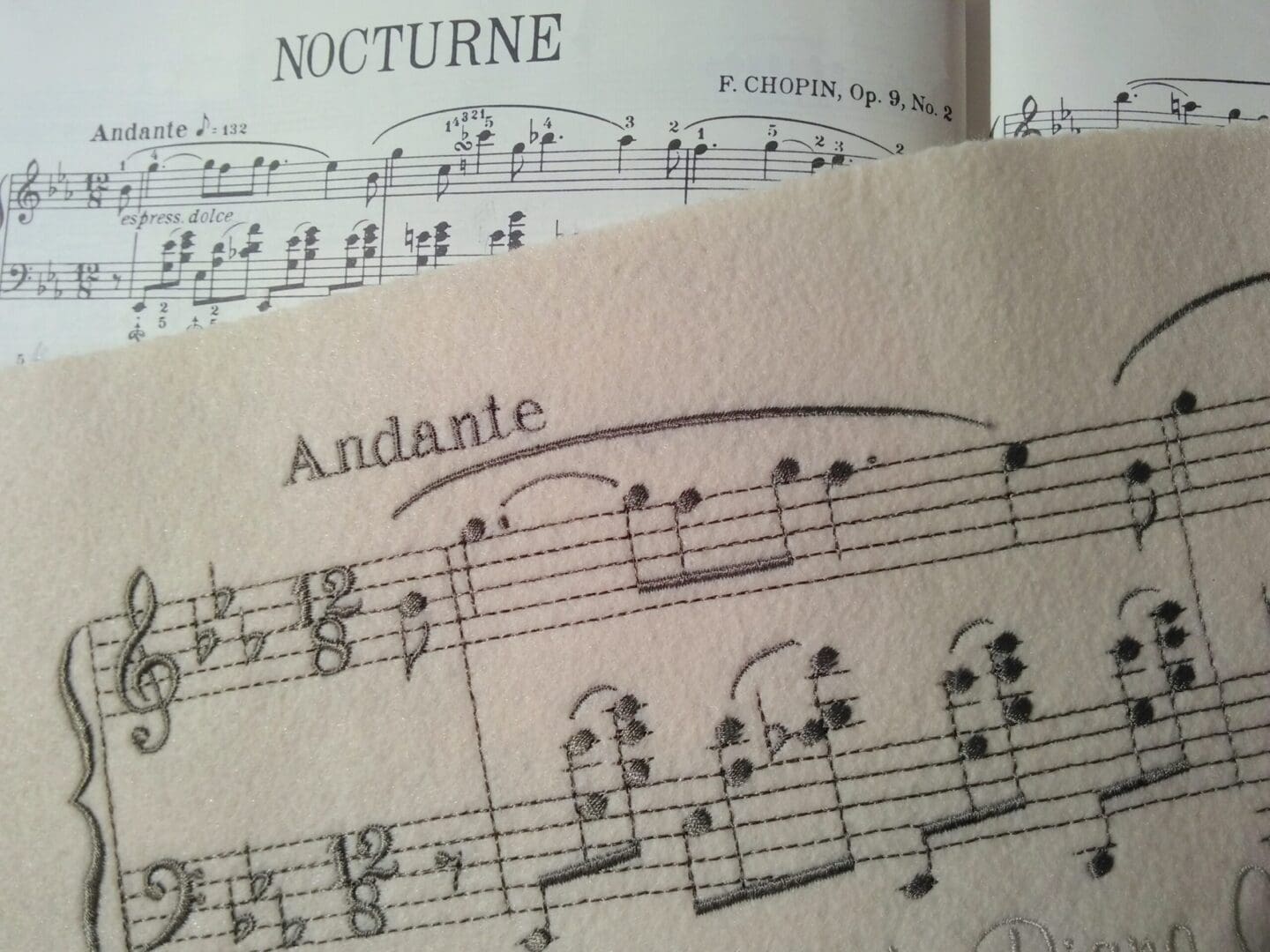
- Chopin Nocturne commissioned embroidered keyboard cover
I still take lessons even now and love to play Chopin. Without learning an instrument I would never have appreciated music at all. Reading music or a score is like having captions / subtitles on a film to clarify what I would otherwise have missed. Just don’t expect me to play spontaneously by ear or sing!
Communicating takes a lot of effort even now and it was hardest of all in the noisy and most challenging environment of all….school…. so the school holidays spent at home were a relief from the din, my Mum never had to worry about keeping me occupied….just make sure that her haberdashery box was full of collected bits and pieces, buttons, zips, thread etc and she would remind me to oil the sewing machine before starting anything. Hopefully I had something made, finished and flattering enough to wear, in time for Saturday night.
I graduated from Loughborough College of Art & Design, in Ceramics and Three Dimensional Design. My Dad had been a student there before being called up during the war and I met my future husband Paul, studying Furniture design there too.
We later set up the business ‘Embroidered Collection’, together and the title has conveniently covered everything I have ever made in stitch and we have both been sustained by our own skills and creative efforts ever since. We are often seen together supporting each others work, at shows and major events.
Looking back at my younger self, I now realise that life has gone by in SEVEN year cycles, for me it was thankfully without the infamous itch. Some of the changes were very subtle, others less so, but I hardly noticed at all, until 4 cycles later, that there it was indeed, a seven year pattern beginning to emerge.
Discovering the spontaneity of free machining.
After completing a small piece of hand embroidery for a college project, I was frustrated at how slow it was, my fingertips and thumb on my right hand shredded and split and were very painful, so as someone who will even sew a button on by machine, instead of by hand, I was goaded to have a go at embroidery on my machine ‘since you do everything else by machine!’ I admit to initially wrinkling my nose up at the thought, but eventually rose to the challenge. Apparently I am allergic to the nickel in sewing needles which explains a lot!
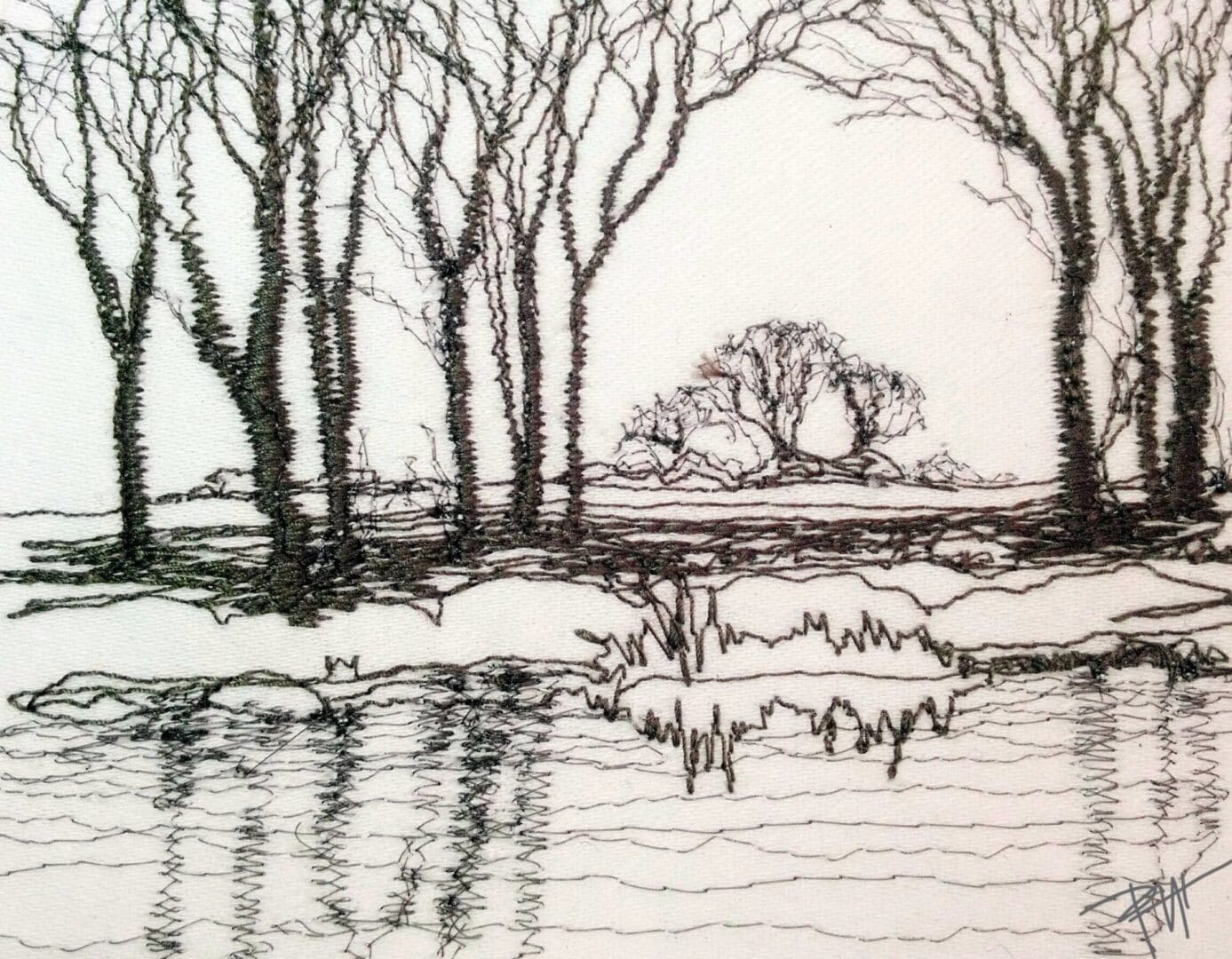
- A quick and spontaneous sketch drawing of a country scene as if the machine needle were my pencil.
So one day, I found myself lowering the sewing machine’s dog feed teeth right down, the very thing that enabled me to do those straight lines of my initiation test set by my mother, and removing the presser foot on my Janome sewing machine, ready to take some cotton fabric stretched tight into a wooden embroidery hoop and sort of just ‘scribbling’ with the machine needle and thread creating a single line that was anything but straight. It was very liberating and quite amazingly spontaneous and quick. I loved it.
The now exposed bare sharp needle, needed some serious respect, these days a special darning foot is available with most machines making it much safer to use when free machining with this technique.
Needless to say, (sorry) I broke plenty of needles in those early stages, mainly because I forgot to lower the needle bar to create the tension on the thread because the foot was no longer there to remind me to lower it……… then not running the machine fast enough to keep up with the movements of my hands on the hoop, drawing with the machine needle and thread so the poor needle was being stressed to bend away from the hole in the needle plate and then shattering with a bang.
So after I had burnt out the motor on my much loved Janome, with the need to run the machine much faster and for long periods of time with little chance to cool down, I confidently moved onto a more robust and basic model of Bernina which I still have, for creating my Thread Paintings of the English landscape onto hand painted silk.
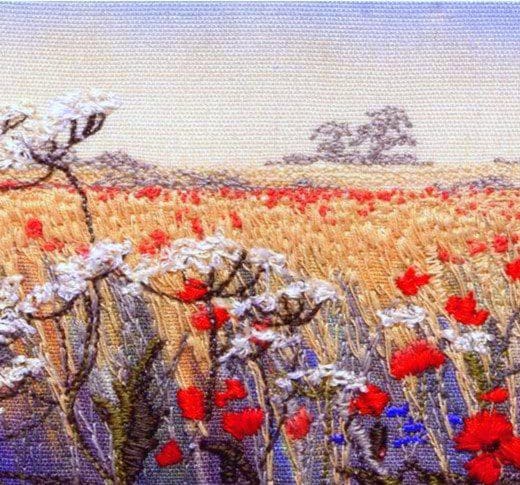
- My early Thread Paintings done on my Janome were very small and kept simple
Repetition and practice are key to improvement, just like throwing a clay pot at the wheel, as I had done at Art College, don’t make it too ambitious, precious or too big and try and try again and then one hopefully improves with time. My early free machined results were small often only 2 inches across, then later a little larger for small mounted and framed pictures.
Most techniques associated with production, make good places to learn and improve, not just sewing technique but also my use of colour, building up confidence to move away from monochrome pencil sketches and create perspective and distance in my landscapes, firstly with pictorial design and horizons, then with fine texture and colour, building a layered effect with each hedge line, trees and fence, increasing the sizes of stitches and thickness of thread as one came into the foreground and the last stages of working the picture.
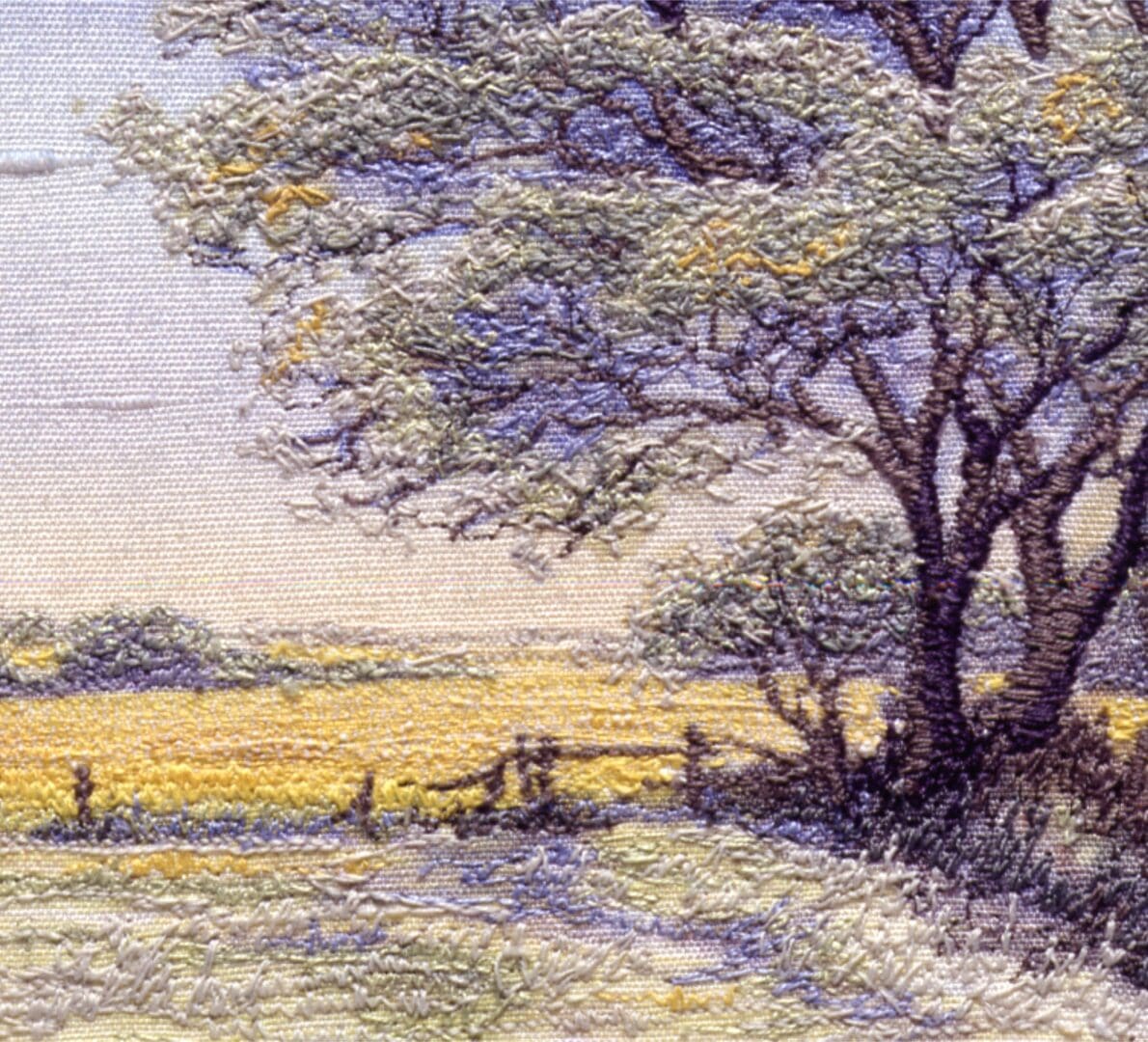
- The monochrome sketches had colour, added in layers from the distance working forward.
My Thread Paintings sold well, at Craft Fairs, Galleries and Exhibitions and I was invited to give talks and displays, did some teaching, wrote a few magazine articles, but never a book, the opportunity never arose and besides I liked the doing and being creative far more.
Visiting a London Ski show in 1985, I saw and watched an industrial embroidery machine just personalising some skiwear, I was totally mesmerized, for here was a machine doing what I was doing, moving the hoop around underneath to a static needle….albeit remotely…. so now another 7 year phase began of my embroidery journey, that of sewing with CAD CAM machines stitching up to what was then an amazing 600 stitches a minute.
But there was a time during my research for a suitable embroidery machine to buy that the suppliers and the commercial embroidery industry thought me completely mad and said that I would never be able to do what I wanted without using a trained professional digitizer….. they talked over my head to Paul instead of me. This determined deaf woman, I guess was too much for this male dominated world at that time…… I reluctantly gave them some of my artwork and they murdered it completely…..
Eventually I was lucky, to meet Tom Clark, an enterprising engineer who was inspired by what I wanted to do and was invaluable with his support and help giving up several of his weekends to make sure the latest machine he was to sell me, had the potential to do what I wanted. It was a fascinating time and I am forever indebted to him.
So I became the proud owner of a twin head SUPERSTAR with 6 needles ( no trimmers and no screen like now) and a digitizing board with the first of the floppy disk readers after the punched tape, two training days and there I was on my own…What had I done?
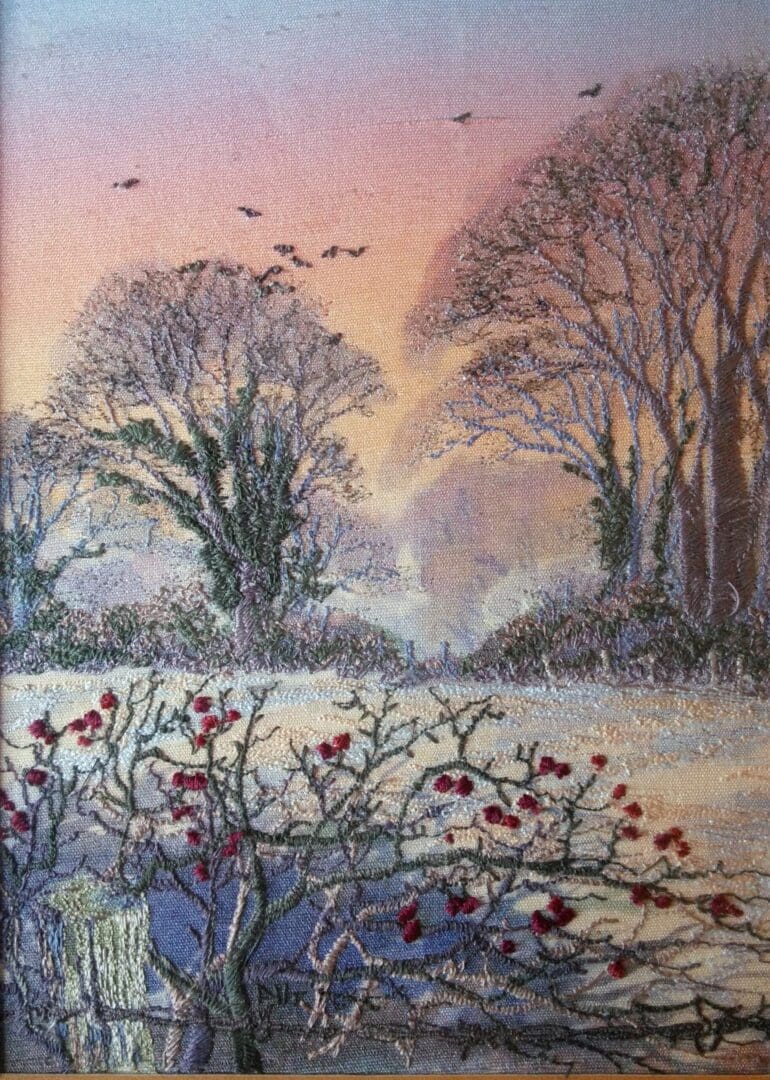
- Hedgethorn, a Thread Painting on hand dyed and painted silk, digitised and produced by Pauline Thomas for a limited production run.
So I learnt to digitise my landscape drawings myself, the hard way….it took 6 months of hard work, a lot of mistakes and positive rubbish but fast forward a few years and my ‘Hedgethorn’ picture as a typical example of the proud result of creating my own path, with new technology and being the first person to create a ‘Thread Painting’ on hand painted silk as an ‘unlimited edition,’ in this way. Much as an artist would print from an etching plate, each one being slightly different due to the inking up of colours each time.
The next phase of my embroidery journey, was shaped by necessity, the economy, aches and pain, opportunity, technological changes, market changes and personal interests and of course the arrival of a full computer screen as we know it now, which forced one of those seismic 7 year changes that I mentioned. The newer machines ran ever faster at over 1000 stitches per minute. No time to stand still.
Now I do not just draw with thread, I colour it in too, with pattern, layers, highlights and form, so decorating things with my designs was the next phase. The Hare became my mascot, featuring again and again, in my designs and popping up everywhere, almost as my stitched signature.
GOLD metallic threads too, used in a three dimensional and sculptural way became a big part of my new work. After all, artistically I am a three dimensional person and not two, as traditionally associated with textile designers.
Creatures with an eye for attitude, flora and fauna all became part of my new landscapes.
My name is Pauline Thomas, I am not always hearing, but always looking, always creating and I love what I do.
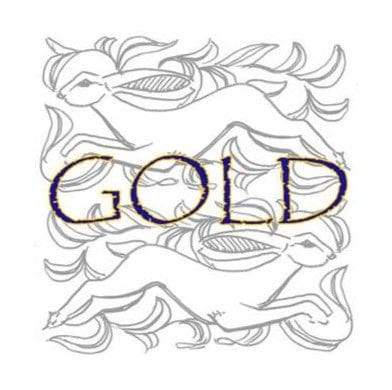
Before you go…. Feel free to comment…. Subscribe if you want to read more… I promise it will be shorter
